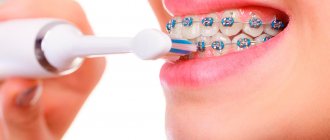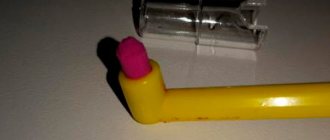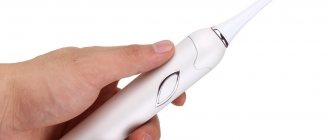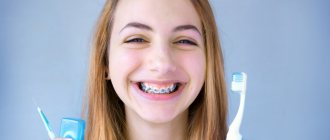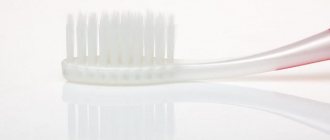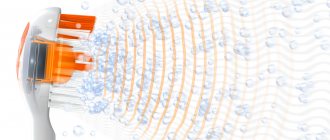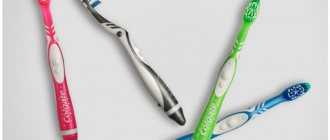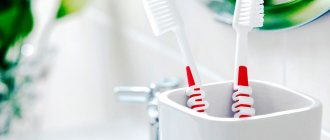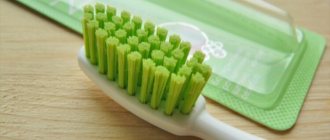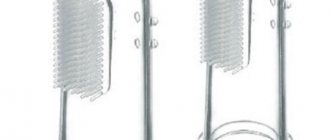Wearing braces does not replace the need to take care of your teeth. During the period of correcting the bite, the issue of hygiene arises especially acutely, because neglecting this point can lead to the development of caries. Treating teeth while wearing braces is inconvenient and undesirable, so it is better to prevent the problem than to solve it. Following simple care recommendations can significantly reduce the risk of inflammation or diseased teeth.
It is important to understand that the orthodontic structure itself in the mouth already increases the risk of plaque and tartar formation on the teeth and can cause inflammation in the oral cavity and gums. This does not mean that you need to abandon bite treatment, but it is necessary to increase attention to care issues.
A special brush is a must have for braces wearers
Orthodontic structures require increased attention from their owners. It is necessary to carefully monitor your diet so as not to damage the archwires, ligatures or break off the clasps. It is especially important to properly and fully carry out hygiene, which, as you might guess, is very difficult for wearers of braces. Can I clean my braces with a regular brush? If you do not brush your teeth properly, especially at the place where the locks are attached, at the gums and in the spaces between teeth, demineralization of the enamel, multiple caries, and gum inflammation may occur. Therefore, oral hygiene products must be special: not only able to fit into all possible gaps in the structure, but also without the risk of damaging it.
How to choose the right one?
When choosing a suitable device, you must consider the following important nuances :
- Length of bristles - if the teeth fit tightly together, then it is better to choose a product with short bristles. If there are small gaps between the teeth, then a product with long bristles would be an ideal option.
- Brush length - small sizes are suitable for children, larger sizes for adults (L, XL).
- Bristle hardness - dentists advise choosing products with medium bristle hardness. But people with sensitive or damaged enamel should give preference to soft brushes.
- The length of the handle of the product should be based on personal considerations of comfort during cleaning. Some people find it convenient to hold a product with a short handle, others with a long handle.
- Product quality - it is advisable to choose products from well-known brands, after studying consumer reviews.
According to dentists, the most convenient to use are cone-shaped brushes.
They not only effectively clean braces, but also interdental spaces, eliminating plaque and bacteria accumulation.
V-shaped brush for braces
Cleaning braces involves two multidirectional tasks: on the one hand, it is necessary to thoroughly clean out plaque and food particles, on the other hand, this must be done as carefully as possible so as not to damage the structure. Brushes with soft bristles and a special recess for locks - V-shaped - can handle this. They can clean the area around the bracket and the bracket itself at the same time. They tend to be more resilient when wet because they are made from polyester, which can absorb moisture better than the nylon used in regular brushes. And the soft bristles prevent damage to the gums and are suitable for increased tooth sensitivity.
Nutritional Features
Installing braces implies not only compliance with the rules of caring for them, but also certain restrictions in the process of eating. So, in order not to create unnecessary problems for yourself, it is recommended to refuse:
- solid foods that can negatively affect your bite;
- sticky and viscous foods that can negatively affect the enamel;
- products with dyes, as they will change the color of the structure and make it unsightly;
- excessively cold or hot food, which can affect the physical properties of the system and reduce its efficiency.
It is important to know: A mandatory requirement is to refuse, unconditionally and completely, from chewing gum. This harsh approach is justified by the fact that the sugar it contains causes caries, plus, chewing gum can lead to braces coming off, which will lead to an increase in the number of visits to the doctor and delay of treatment.
Can I clean my braces with an electric brush?
Electric toothbrushes can be used in patients with braces. In this case, you need to choose special attachments: narrower and with soft bristles. It is desirable that it operates in reciprocating rotation mode. It should be taken into account that the bristles of an electric toothbrush wear out much faster in orthodontic patients. Approximately every two to four weeks you will have to change the attachments. However, it does not relieve the “brace-bearer” from using other hygiene products, such as brushes or mono-tuft brushes, which allow you to clean the narrowest and hard-to-reach places.
Lifetime
Answering the question about the duration of wearing the structure is not as simple as it might seem. This aspect is influenced by the following factors:
- the age of the patient - the younger he is, the less time is needed;
- degree of complexity of the problem - the simplest situations will require wearing the system for no more than a year, the most complex ones will require much more time;
- the health status of the patient's teeth - if there has been no prosthetics or depulpation before, then the wearing time will be shorter.
Three years, if we talk about the most problematic cases, of course, is a considerable period of time; to many, even one year seems an unreasonably long time, but it is still not worth using devices for acceleration. They are very expensive, but are not able to change human bone tissue, so their purchase is not justified. You also need to remember that ignoring proper and high-quality oral hygiene will lead to a delay in treatment and a decrease in its effectiveness.
Toothbrush for braces
Cleaning the space between the bracket and the arch, interdental spaces and hard-to-reach places is not an easy task. That is why, after installing braces, doctors recommend that their patients use y or toothbrushes. They easily remove plaque in hard-to-reach areas and between teeth. Their bristles are longer than regular brushes, and their heads are much smaller, which allows them to penetrate deep under the orthodontic structure and effectively cope with plaque in the area of wisdom teeth and crowded teeth.
Devices for cleaning bracket systems
Braces are available from different materials. These are metal, ceramics, medical sapphires. Each system has hard-to-reach places, as well as elements that require careful handling. Rough cleaning of the structure will damage the braces and even the enamel, so it is important to follow the advice of orthodontists and use the recommended devices. Among them:
- Ortho brush.
- Mono-beam (single-beam) brush.
- Interdental dental brush.
- Superfloss, floss, threads for cleaning teeth.
- Irrigator.
In addition to toothbrushes you will need:
- Toothpaste – regular or orthodontic.
- Foams for cleaning braces.
- Mouthwash – for gums and teeth.
- Solution for irrigator – with antibacterial effect.
Additionally, orthodontists include wax in the kit for patients. Its task is to protect the oral mucosa from injury by hard and protruding segments of the brace system.
V-shaped orthodontic brush
The ortho brush differs from the classic height of the bristles - elongated around the perimeter and short in the middle. This arrangement improves the quality of teeth cleaning. With horizontal movements of the orthobrush along the jaw line, the central rows of bristles clean the clasps and arch, and the bristles along the edges clean the interdental space and open areas of the teeth.
There are several things to consider when choosing an orthodontic brush. The product must have:
- soft pile;
- good thickness;
- head sizes up to 3 cm.
Compactness guarantees maneuverability and access to all teeth, and the soft bristles do not harm the enamel of the orthodontic structure.
Mono-beam brush
The single-tuft brush is designed for targeted cleaning of hard-to-reach areas. The product has a curved L-shaped handle and a small tuft of bristles at the end. The beam is made in such a way that when cleaning it completely covers the neck of the tooth.
Rodikova Tatyana
It is better to take mono-tuft brushes with soft bristles. And you don’t need to be afraid that they don’t clean well. At the appointment, I teach how to use this tool correctly, so the quality of care for my patients is always excellent.
Can I clean my braces with a regular or electric toothbrush?
A classic toothbrush is prohibited while wearing braces. You can clean it, but it will not do any good. Removal of dirt will be superficial, and hard-to-reach areas will remain uncleaned.
As for electric models, they can be used, but with reservations. Rotary and sonic electric brushes with soft bristles or orthodontic attachments are permitted. Ultrasonic options cannot be used, since the aggressive influence of ultrasound negatively affects the structure of the adhesive composition and can easily cause damage to the corrective structure.
You can return to using electric toothbrushes after removing your braces.
Orthodontic interdental brushes
Brushes are small brushes with short bristles. There are three product options in orthodontics:
- cylindrical - uniform height of bristles arranged in a spiral relative to the axis of the structure;
- cone-shaped - short villi at the top and elongated at the base of the brush;
- curved - the working part is located at an angle to the handle.
Angled and cone-shaped brushes clean best, but cylindrical ones are also allowed. The device perfectly removes plaque around the braces, under the arches and between the teeth.
The bristles of the brush and the areas between them quickly become dirty, so you should change the brushes every two weeks.
Dental floss for cleaning braces - floss or super-floss
For thorough cleaning of the brace system, doctors recommend superfloss. This dental floss has rigid ends, which makes it easier to pull under the archwire, and has a complex structure that guarantees high-quality cleaning. The second option is waxed floss for cleaning teeth, which glides and does not cling to braces. Otherwise, dental floss is selected as usual - according to manufacturer and thickness.
Plaksina Margarita
I recommend super floss to my patients. This is a fixed size thread with a hard tip. Moreover, it has variable thickness and areas with a spongy structure, which allows it to literally absorb plaque and clean tooth enamel well.
Oral irrigator
An irrigator is a device that cleans teeth with a narrow directed jet released under a certain pressure. When choosing a model, you should pay attention to:
- Type – compact with batteries and a compartment for water or bulky stationary with mains power.
- Pressure – permissible adjustment in the range of 0.7-4.8 bar.
- Modes – types and quantities.
- Variety of attachments.
- Compact size.
Irrigators perfectly clean interdental areas and hard-to-reach areas of orthodontic structures, but do not replace toothbrushes. This is a helper tool.
Toothpastes – orthodontic and plain
Orthodontists give the following recommendations regarding toothpastes:
- During the first weeks after installing braces, avoid products containing high amounts of calcium and fluoride.
- After the enamel gets used to the presence of the corrective structure, give preference to fluoride-containing pastes.
- Buy enzyme-containing formulations to quickly break down food debris and reduce the rate of appearance of pathogenic microflora during the day.
It is also allowed to use familiar toothpastes - the choice is up to the patient.
Foams and gels - quick cleaning of braces
Dental foams and gels can create additional antibacterial protection and quickly remove plaque from teeth. The products have a thick, dense consistency and are well applied to orthodontic structures. These are excellent preventative agents for preventing the formation of caries and tartar.
Foams and gels are a solution for quick hygiene. For use on the road, at work, at school, on a trip - when you don’t have a toothbrush with you.
Dolotova Marina
Many patients are surprised that there are such wonderful foams. They are really comfortable. The consistency is like a gel. They clean perfectly and have an excellent antibacterial effect. Especially indicated for children who cannot brush their teeth after school breakfasts and lunches.
Mouth rinses
Rinsing your mouth after eating and brushing your teeth is a necessity. Especially if it is not possible to carry out proper care and brush your teeth. Special means act comprehensively:
- freshen breath;
- destroy pathogenic microflora in the oral cavity;
- protect against caries;
- reduce the risk of inflammation.
Ultrasonic brush for cleaning teeth with braces
Ultrasonic brushes can greatly simplify oral hygiene for orthodontic patients. A brush operating on pure ultrasound does not even require sweeping movements on the surface of the teeth, which means that its head does not wear out due to constant friction against the clasps and arches of braces, and there is no risk of damaging the structure. Ultrasound effectively removes plaque and even tartar, penetrates deeply into the gums, and fights microbes in periodontal pockets. Using a special toothpaste that can create microbubbles allows you to clean your mouth even more efficiently.
What happens if you don't use it?
If you do not use special brushes for cleaning, then in the future there may be such negative consequences as:
- Formation of tartar (due to the accumulation of plaque in hard-to-clean places).
- Darkening and thinning of tooth enamel.
- The emergence and development of caries.
- Darkening of the metal arches of the bracket system itself.
To avoid various risks, it is recommended to use such brushes regularly. Otherwise, the method does not guarantee 100% results.
How to brush your teeth with a braces brush?
First, you should walk along both rows of teeth with horizontal movements, and then with comma-like movements, positioning the brush so that the notch is located in the area of the locks. Be sure to grab the gum area. Then turn the toothbrush so that its long bristles can clean the bottom edge of the braces clasps, and do the same on top. Clean the chewing surface of your teeth with forward movements, and the inside with sweeping movements. Next, use dental floss or special brushes to clean the interdental spaces, the space above and below the arch. At the end of the cleaning, you can use it, adjusted in accordance with the recommendations of your orthodontist. While wearing braces, you need to brush your teeth after every meal, at least three times a day. During the day, you can limit yourself to a brush, paste and brushes; in the evening, when you have more time for hygiene, use a floss and irrigator.
Oral care products
When a person wears braces, he needs to take dental hygiene more seriously. Standard cleaning with regular brushes will not help here. Food debris accumulates not only between the teeth, but also in the elements of the orthodontic device. It is quite difficult to clean them, so pathogens quickly spoil the enamel. After some time, plaque forms on the teeth, gums become inflamed, bleeding and caries appear.
While wearing braces, a person must purchase several types of products for cleaning the oral cavity. Special products include a monotuft orthodontic brush with V-shaped bristles and a brush for cleaning braces. Standard dental care products include a classic brush, toothpaste, mouthwash and floss.
You will have to brush your teeth that have special structures installed on them more than twice a day. Dentists strongly advise carrying out the procedure after every meal. If it is impossible to brush your teeth with a brush (for example, at work or school), then your mouth should be rinsed with water or a special liquid.
Sometimes orthodontic products are sold in ready-made sets, which are more economical than products sold separately. The average price of a set varies between 800−1000 rubles. You can purchase a set of brushes in pharmacies, dental clinics or online. Some kits contain paste, rinse aid, floss and orthodontic wax.
Option for a braces care kit
Where can I buy a brush for braces?
Today it's pretty simple. Prices for brushes for braces vary depending on the company. Orthobrushes cost from 200 rubles, single-beam ones - from 260 rubles, orthodontic attachments for electric brushes will cost from 300 rubles and more.
In addition to the usual care with toothpaste, brushes, floss and brushes, dentists recommend using irrigators. They are able to remove food particles even from the most difficult to reach places without damaging the orthodontic structure. Modern devices are equipped with several operating modes, allowing you to use both mono jet and bubble cleaning for more effective hygiene.
Adaptation period
Getting used to the system and the devices used to care for it will take some time. While adaptation continues, the patient will have to experience some discomfort when eating, and he will also have certain problems with diction, but there is no need to be afraid and despair, such troubles will be overcome quite quickly.
On average, an adult will need no more than 10 days to get used to it; a teenager or young man will need even less, a maximum of a week. Painful sensations may not necessarily occur only in the teeth that experience pressure from the plates; often the gums also experience discomfort. If adaptation is very difficult, then the dentist may, at the patient’s request, slightly weaken the system so that the painful sensations are not too strong; in addition, it may be necessary to take painkillers.
A special place is occupied by special means that are used to care for oral hygiene. Their use extends throughout the entire period of wearing braces; moreover, care during this period should be especially thorough.
Review of models of orthodontic brushes from other companies
| Model name | Characteristics |
| Vitis |
|
| Pierrot |
|
| Curaprox (mono-beam) |
|
| Miradent (mono-beam) |
|
| Vitis "Implant Monotip" |
|
| "Antiplaque Piave Dental Care" |
|
| "Antiplaque Piave Dental Care" (mono-beam) |
|
| "EDEL+WHIT" beam |
|
Recommendations
The effectiveness of cleansing will largely depend on the correct implementation of the following recommendations:
- It is better to give preference to synthetic bristles rather than natural ones, since the latter has many pores where harmful bacteria accumulate, causing inflammation;
- the diameter of the brush head should not exceed 250 millimeters for adults and 200 for children;
- soft bristles are better than hard bristles in terms of penetration;
- It’s good to also use an irrigator after cleaning, which can wash away food debris from those places where the brush could not fully reach.
